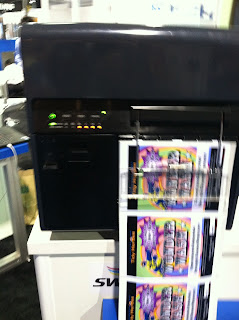Recently, I got my
hands on a Primera PX450 color printer (http://www.primeralabel.com/px450_features.html) to complete some test prints. I like to summarize my experience printing
with this device. Please remember; I am
not a Primera expert and only wanted to learn/share my thoughts about this
printer.
As a reminder, the PX450 is a 3 color, USB connected printer
that produces labels, receipts, tickets and other types of output from 1” to
4.25” wide. When I first saw the machine, I was surprise the size; it has a
small footprint and is light: only 7
pounds. One key point: Primera describes this printer as a POS
printer. This fact was news to me.
I first downloaded the driver from the Primera
website: http://www.primera.com/primera_printer_drivers.html. Also, I checked for any firmware updates; none were
available. When I first downloaded the
driver, I could not find the driver on my computer; only a set of instructions
popped up. I tried to find the driver;
but could not. In the instructions, I learned the driver was stored on the C
drive; and stepped me through the process. Easy.
After installing the driver, I went to the driver defaults
to setup the printer:
Generally, the driver seemed very easy to understand.
To start, I placed die-cut, 4” x 4” media obtained from
Primera into the printer:
No matter what I did, I could not get the media to register
correct:
Trying to troubleshoot this issue, I learned to two key
facts about this printer. First, Primera
does not recommend this printer for die-cut or any labels.
What seems strange about this restriction is that the
printer driver has the settings for die-cut and blackmark. In addition, the printer has a gap and
blackmark sensor. Finally, the
instructions show how to print these label types.
Second, I learned the max OD for media in this printer is
5”. The roll of labels I had from
Primera was 5.5”. After stripping off the
extra labels, it still would not print the die-cut labels correctly. It seemed the roll was just too heavy for the
printer to pull through the printhead.
In order to test other types of media, I tested a 4”
continuous gloss paper roll. Very
quickly, I got this printer to print the media.
Every time, however, the printer would not cut the media correctly. One end would not cut:
Given the problem with the cutter, I tested a 3” matte poly
label. Immediately, I knew I had a
problem as the printer would not cut the poly label material:
On the label, you can see the marks from when the printer
tried to cut the poly material.
Next, I tried a 3.25” matte paper label; and printed labels
at both level 4 (left) and level 2 (right) print quality. Both prints were completed using the graphics
mode.
I felt the print quality was very good, even at the lower
quality using the PX450. In fact, the
lower quality produced better looking barcodes.
In the process of printing these two 3” x 3” labels, I used
my iPhone to measure the time it took to print the labels. At the level 2 quality, it took 22 seconds to
print one label; from the time I hit print to the label was cut. At the level 4 quality, it took 59 seconds to
print one label. To produce the same
label using the same material, the TM-C3400 took 15 seconds (configured for low
print volume which costs 3 to 4 seconds per print job). The print quality seemed slightly better for
the TM-C3400 set at the Level 3 setting than the lower level 2 setting of the PX450.
To summarize my thoughts after testing the PX450:
· * Produces high quality images
· * Not recommended for die-cut or blackmark labels;
maybe any labels
· * Prints slow, especially at higher resolutions
· * Unavailable Ethernet connectivity
Based on these findings, I would not recommend the PX450 for
any production process or situation. It
may work as a device to complete test prints; say for a graphic artist
designing labels.
I hope you find this information of value. In the near future, I want to test other
color label printers. If you have one,
loan it to me to test.
Guy Mikel






































